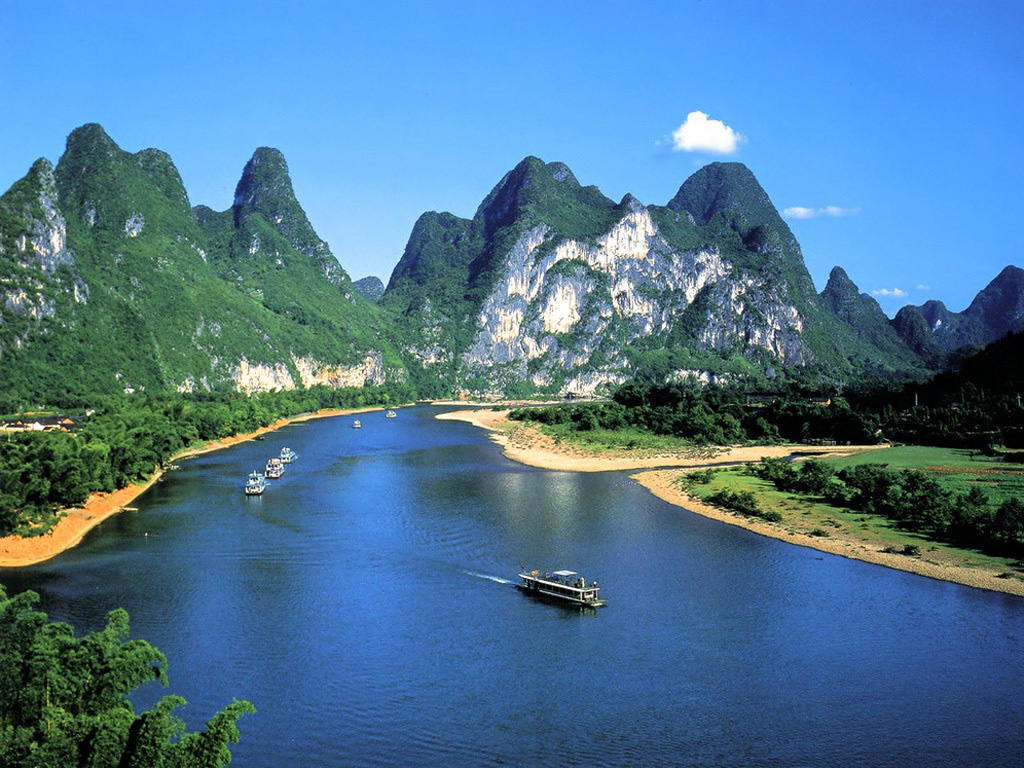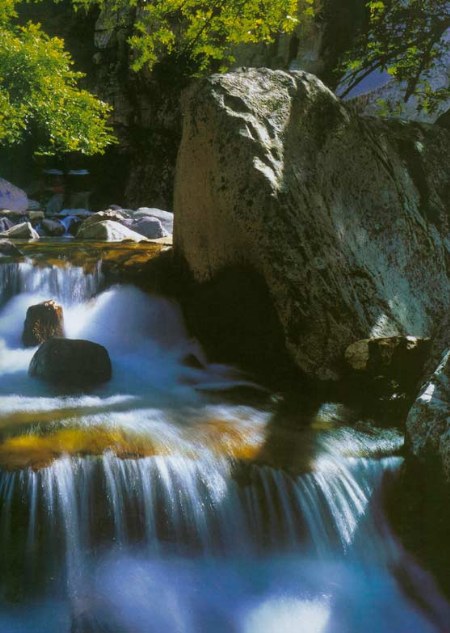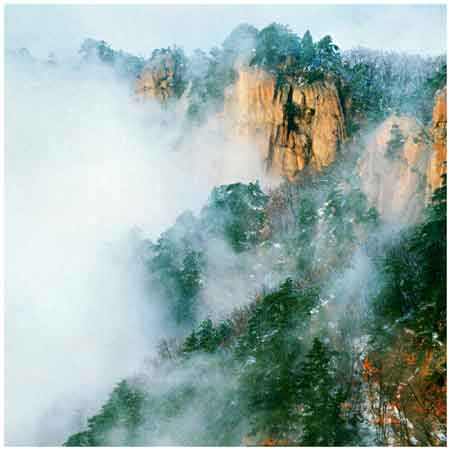(单词翻译:单击)
Shi Du(十渡)
Shi Du--the Ten Crossings are situated about 100 kilometers to the southwest of Beijing on the upper reaches of the Juma River. To get from Zhangfang village to Shi Du, it is necessary to cross the Juma River ten times, which is how the spot got its name.
The scenic spot is filled with sparkling streams, marshy swampland, and gushing springs. Adventure seekers can try horseback riding or bungee jumping. The earliest bungee jumping facilities in Beijing were built here, with one platform at 48 meters and another at 55 meters.
There are two styles of bungee jumping for daredevils to try: with the cord linking around the waist, and the more demanding one, which links to the ankle. Whichever they choose, those adrenalin junkies will experience a challenge to themselves, and a feeling of jumping into the arms of the nature.
Admission: Separately charged at each scenic spot
How to arrive there: Take Bus 10 (Time of Departure: 6:00--8:30a.m. on Saturday and Sunday) at Qianmen, Fuchengmen or Xuanwumen through to the site; Take Train 7095 (from Beijing Western Rail Station - to Tianyuan) at Beijing Southern Rail Station at 6:38 am through to Shidu; Take Bus 917 at Tianqiao (or Liuliqiao) through to Shidu.

Eighteen Ponds(京西十八潭)
Eighteen Ponds lie within the borders of Anjiazhuang of Wangping Town in Mentougou District, and features deep valley, unique stones, special streams and uncommon flowers as one of rare natural scenic spots in North China.
The pools group is backed by the Qingshuijian which is one of top 4 peaks in Beijing. There are roaring streams along peaks over peaks, waterfalls down from each cliff, ravines forming pools in the valley, forming a famous the natural landscape of "three-waterfall, six-scene and Eighteen Ponds" with distinct seasons. While, another scenery is revealed at the mouth of the valley: two door-like mountains overlooking the valley, zigzagging peaks, peculiar cliffs and stones, flying spring hitting against cliffs. There are also a great amount of birds, animals and flowers.
Admission: RMB 20 Yuan
How to arrive there: 1. Take Bus 929 Branch (200m west out from Pingguoyuan Subway Station), and get off at Eighteen Ponds in western Beijing. 2. Take Train 815 at Yongdingmen and get off at the site (of 34 km away). 3. Drive along the National Road 109 at Lianshi Road or Fushi Road for 52km and arrive at the Eighteen Ponds in western Beijing.

Black Dragon Pond(黑龙潭)
Black Dragon Pond Scenic Spot is located in a 220-meter high, 4-kilometer long valley, which is 100 kilometers away from Beijing. The valley is in the northwestern Lupiguan Pass of the Shicheng Town in Miyun. The valley is commonly called Gulu Valley, because of its steepness. There are three waterfalls and eighteen pools in the valley. It is always appraised as being fresh, astonishing and steep.
Being fresh:
A lot of waterfalls are located in this only four-kilometer valley, which is rare in and outside Beijing District. Everywhere can give people a fresh feeling from the beginning to the end of the journey. You will feel relaxed and happy, just as if you were in a fairyland.
Being astonishing:
Every scenic spot has its own fantastic characteristic in this deep and serene valley. The great power of the nature makes the valley full of wonder and surprise in each scenic spot.
Being steep:
The waterfalls and the Dragon Pool are majestic and spectacular because of the adventurous rushing water, the deep valley and the narrow path. Tourists can enjoy the landscape in a perilous situation when they climb the ladders and pass the bridges. No venture, no pleasure. The views in the dangerous place can add more vigour to the tourists.
Admission: RMB 36, RMB 26 for students

Lianquanxianggu(濂泉响谷)
Lianquanxianggu Natural Scenic Spot is located at the foot of the Great Wall in the northwestern Huairou District, in front of Heituo Mountain, and 80km away from Beijing. There are waterfalls pouring down from the Heaven and springs babbling along the valley, where sounds of waterfall and springs echo each other, that is why it is called the "Lianquanxianggu" (waterfall & echoic valley). The Lianquanxianggu boasts verdant hills and green water, perilous peak and ravine, joyous spring and flying waterfall, heavy forests and remote caves, unique mountains and rocks, as well as 3¡æ-5¡æ lower temperature than that in downtown. It has such main landscapes as Thien Cung Cave, Maotou Hill, three-pool and two-waterfall, reed and valley of loneness, glacier in May, turtle of longevity, primitive second forest, etc.
Also, some service facilities are provided, inclusive of quadrangle dwellings, Mongolian yurts, small wood houses, restaurants, stores, hot spring hotels and karaoke bars. Tourists can enjoy flowers and grasses on mountains in spring, natural landscapes in summer, red leaves in autumn and natural ice waterfall in winter. Meanwhile, they can fish red trout, go for a picnic, have a barbecue, and hold a bonfire evening.
Admission: RMB 15 Yuan for adults, half price for students
Best time for sightseeing: Summer

The No. 1 Waterfall(京都第一瀑)
The No. 1 Waterfall in Beijing is located in the Miyun County in Beijing's suburb. Five big characters of "The No. 1 Waterfall in Beijing" are engraved on the cliff on the left of the Waterfall, which is 62.5m high, 28m higher than "the Waterfall to the Heaven" close to it in the Heilong Pond. The Waterfall Waterfalls throughout the year and its flow rate is about half a cubic meter even in the dry seasons of winter and spring.
The source of the Waterfall is the Liu River, which originates from the Yunmeng Mountain in the Huairou County, converges all mountain springs and creeks in the course of flowing along the east foot of the Yunmeng Mountain and washes out and creates a series of natural sights along the way, for example the "Connected Six Ponds", the "Jade-Splashing Waterfall", the "Waterfall Hung in the Air" and the "Nostalgic Pond", which are all the "masterpieces" of the Liu River. The No. 1 Waterfall in Beijing is the last sight of the Liu River before it merges into the Bai River. The dark green and transparent pond water is smashed by the Waterfall like flying pearls and splashed jades and looks like flying dragons and tigers from nearby and fog and smoke from afar. When the sunlight shines into the valley, it presents a ring of light in seven colors, a rainbow on the earth. The roar of water echoes in the vacant valley and the powerful and majestic momentum of the Waterfall has people linger on.
The "Blue Dragon Pond", the name of a pond under the "First Waterfall in Beijing", is 8 m in the deepest. After it's filled to the full, water runs on and into the Bai River, which is one of the water supply sources of the Miyun Reservoir.
High peaks in the scenic spot pierce directly into the sky like huge swords and show different attitudes vividly. The scenic spot is 3 km in length and the drop in elevation is 200 m. Scenes change and different colors are presented when you move and unique ponds connected with each other seem masterpieces of superlative craftsmanship. All tourists hate to leave when they come here.
Admission: 30 RMB
Transportation: 1. take a coach at Dongzhimen to Miyun and transfer to the coach going to the direction of Sihetang and get off at Zhangjiacun; 2. take Train No. 559 at Beijing North Railway Station to Shitanglu Station and take a bus to it; 3. drive along the Beijing-Miyun Highway to Miyun Reservoir, turn northwest, proceed for 13 km and you will arrive at it.

The Great Canyon(京东大峡谷)
The Great Canyon in East Beijing, located north of Yuzishan Village, is composed of two scenic areas: the grand canyon and Jingtai Mountain. The scenic area is adjacent to Panshan Mountain in the south, and to the Jingdong Cave, Jinhai Lake, Huangyaguan Great Wall, the Eastern Tombs of the Qing Dynasty and Wuling Mountain in the east, and is about 82 kilometers from downtown Beijing. Since its opening in 1992, many visitors have flocked to the area and it is a well-known scenic area in Beijing and Tianjin.The canyon, about three kilometers long, boasts of dozens of natural sceneries and landscapes, such as green mountain and crystal water, caves and ponds, waterfalls and springs.
Highlights
In the sunny spring time, flowers are everywhere on the mountains; in summer, all mountains become green, mountain springs gush and flow, and visitors here would feel cool away from the suffocating summer heat; in autumn, all trees on the mountain turn red and golden, and visitors have the chance to harvest ripe fruits; and in winter, the mountains are covered with snow and ice, and the waterfalls become icy, producing a polar scenery.The scenic area has more than 60 tourist attractions. It has two special scenic areas: the Jingtaishan Forest Scenic Area and the Canyon Scenic Area. At the bottom of the canyon, there are five deep ponds connected by brooks, six tourist function zones namely canyon expedition zone, mountain-top sightseeing zone, water amusement zone, exhibition zone, fruit-picking zone and the leisure.




